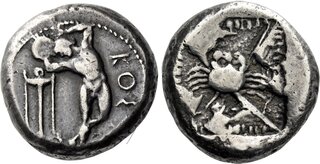| Numismatica Ars Classica > Auction 146 | Auction date: 8 May 2024 |
| Lot number: 2227 Price realized: This lot is for sale in an upcoming auction - Bid on this lot  | Show similar lots on CoinArchives Find similar lots in upcoming auctions on |
| Lot description: Cos. Triple siglos circa 480-475, AR 24 mm, 16.54 g. KΩΣ Discobolus about to hurl disc; in l. field, tripod. Rev. Crab within incuse square. SNG Lockett 2922 (this coin). Barron, Essays Kraay-Mørholm, 6f (this coin). Boston, MFA 2014 (this reverse die). Extremely rare and undoubtedly one of the most fascinating issues of the entire Greek series. Unusually struck on fresh metal. A very pleasant old cabinet tone. Good very fine Ex Hess 7 October 1907, Duplicates Münzkabinet Berlin, 728; Hess 25 March 1929, Vogel, 357; Glendining's 21-23 February 1961, Lockett, 2397; Glendining's 10 December 1986, Knoepke, 300; CNG Numismatic Review 25, 2000, 50; Hess-Divo 283, 2000, 95 and Gorny & Mosch 112, 2001, 148 sales. From the Imhoof-Blumer collection. Seldom do designs of such contrasting qualities appear on a single coin: the reverse is fixed both in the sense of its formal presentation and its role as a recurring type at Cos, whereas the obverse is original and animated. It portrays an athlete at the moment of releasing a discus – no easy feat for an engraver working in a framework the size of a die. The meaning of the type has attracted many theories. It clearly is an athletic theme, and the tripod of Apollo is such an integral part of the design that it must be assumed to be essential to the meaning of the type. The tripod has thus been seen as a reference to the festival of Apollo at Triopion, where athletes competed for bronze tripods that would be dedicated to Apollo at the local temple. Participation in these games was limited to cities of the Doric Pentapolis: Knidos, Ialysus, Lindos, Kamiros and Cos. Since none of the other four cities produced coins commemorating this event, it is possible that the type celebrates otherwise undocumented games held in Apollo's honour at Cos. The type was produced over the course of decades, for there is significant evolution in its presentation. The earliest issues – to which this coin belongs – have an abbreviated ethnic and show a crab of varying size in a modified incuse within which an \X\\ pattern is integrated; in some cases, the crab is absent. The next series is transitional in that the inscription starts in its abbreviated form and eventually is expanded to incorporate all five letters; the reverse retains its square incuse, though the field is flat and unadorned except for a prominent beaded border. The final series begins with the longer ethnic and finishes with the original, three-letter version, and the reverse is modified to a circular format with a beaded border. Assigning a date to the series, as Barron notes in his study, is difficult because of a conspicuous lack of hoard or overstrike evidence. Furthermore, much of the discussion centres around the date of the Athenian coinage decree, which Barron had firmly placed in circa 448 B.C., but which is now generally believed to have been passed in the 420s, thus changing a key element in the chronological debate. Estimate: 75000 CHF |  |



